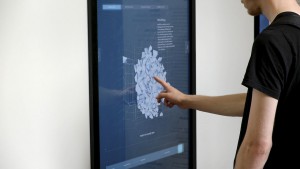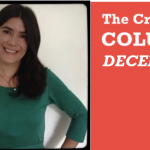German design team creates “Next Generation Scientific Poster”
The scientific poster is a format in huge need of a makeover when it comes to information design, user interaction and technology. All these three aspects are addressed by the “Next Generation Scientific Poster” project by The Muthesius Academy of Fine Arts and Design in Kiel, Germany. Pieter Torrez of Crastina got in touch with Professor Tom Duscher, interaction designer, for an interview.
Next Generation Scientific Poster — a Vimeo movie.
Hi, Tom! Can you briefly describe what you and your team have been working on the last years?
We examined which new media formats can be developed to represent scientific themes and topics in a sensory and experimental way. The Muthesius Academy of Fine Arts and Design in Kiel, Germany has successfully set itself the task of finding artistic solutions, in particular concerning (audio-) visual and scenographic representations of science for many years and aimed to extend and intensify the core research area of science v isualisation . One of our most successful developments was the ‚Next Generation Scientific Poster‘. Our initial research and development work was driven and funded by the research program of the cluster of “Future Ocean” in Kiel. The “Next Generation Scientific Poster” has won several design awards, one of them is the very well known and internationally respected ”German Design Award” for 2016. In order to offer this expertise to researchers in the scientific community all over the world, we recently founded “The Science Communication Lab‘ as a spin-off from the academy. At the SCICOM LAB we are able to make use of the up-to-date experience and knowledge gained from our ongoing research, combine it with excellent visualization competences and find communicative solutions for scientific researchers and their projects and topics with a very high value of representation.
isualisation . One of our most successful developments was the ‚Next Generation Scientific Poster‘. Our initial research and development work was driven and funded by the research program of the cluster of “Future Ocean” in Kiel. The “Next Generation Scientific Poster” has won several design awards, one of them is the very well known and internationally respected ”German Design Award” for 2016. In order to offer this expertise to researchers in the scientific community all over the world, we recently founded “The Science Communication Lab‘ as a spin-off from the academy. At the SCICOM LAB we are able to make use of the up-to-date experience and knowledge gained from our ongoing research, combine it with excellent visualization competences and find communicative solutions for scientific researchers and their projects and topics with a very high value of representation.
How can your solution contribute to solve the problems of the poster format used today at large conferences – information overflow & stress, poor visibility, logistical & printing problems etc.?
Because of the more narrative character of interactive and animated “Next generation Scientic Posters” it is much easier for users to follow and understand the scientific topic. And because of the different levels of information the design of interactive posters doesn’t have to be as overloaded as many of the classical paper posters. We structure the information from overview to detail, so that every viewer can determine the intensity of the information. This means less visual disturbance, more clearness and simplicity in the communication and interaction and therefore less stress and overload. We don’t think that every printed poster should be replaced by an interactive poster because this would mean high costs and less flexibility. But topics which are hard to explain and to visualise in a single graphic will benefit a lot from the possibilities of interactive science communication.
How do you think interactivity is going to contribute to communicating science?
In our opinion, multimedia and interactive science visualisations play an increasingly central role in the communication of science topics. They provide not only the basis for knowledge transfer but also the framework for the acquisition of knowledge. While advanced media sensory realisation techniques have been neglected in science for a long time, in art and design this is a particular field of competence. On the other hand the classical poster does often not offer enough space for the sheer complexity of the contents – texts, pictures, graphs and tables – used to convey scientific research today, but very often leading to the inability to communicate contents and statements concisely. The classical poster also lacks an appropriate possibility for continuous updates which are necessary to include newer research results and would do justice to today‘s constant changes of information.
How is this technology going to be used as it seems rather expensive to replace this with the classical scientific poster? When do you expect this technology to be in use?
We don’t think every paper-based scientific poster has to be replaced – simply because the classical approach does have the quality of being quite spontaneous and therefore flexible and rather low in price. But there will be more and more occasions where it makes great sense to invest the additional effort and expenses in digital technologies to benefit from the higher quality of design and communication opportunities. For example at conferences and exhibitions. Or at demonstrations as we had one on the german research vessel ’Sonne’: there was not enough space to have several paper posters, but the interactive posters fitted perfectly. In science centers, where you want the visitors to get active with a scientific topic. Or if you use realtime data in your visualisations extensively. There is no better way than filter, sort and visualise that data in interactive posters. This technology is already happening today and with the rising awareness of scientists for communication about their research it will be used more often in the next five years.
What are your future plans with the development of the poster?
At the moment we are defining our product range from compact and less extensive versions of the interactive poster to complex and detailed versions. We’re also developing a more self explaining version of the interactive poster so that users can inform themselves without a scientific presenter. This version will be on several exhibitions such as the German research vessel „MS Wissenschaft“. We’re also developing modules out of the existing framework. With that modules we can built new posters which are more flexible in presenting new content.
- Break it Down: Refreshing Science Communication - February 8, 2017
- How to create clear and attractive graphs/illustrations? - September 5, 2016
- How platforms like External Diffusion can highly improve the outreach of your research paper - April 18, 2016
- How platforms like Clarafi can drastically improve your scientific visualization skills - April 6, 2016
- How social platforms like AcademicLabs can make it easier to find the right research partners and aim high - March 23, 2016
- How science communication agencies like Mediomix can enlarge the outreach of your research - February 29, 2016
- How Life Science Network can create networking opportunities for scientists - January 27, 2016
- German design team creates “Next Generation Scientific Poster” - December 13, 2015




Leave a Reply
Want to join the discussion?Feel free to contribute!